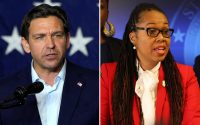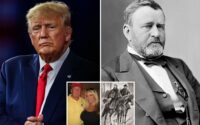A look back at Queen Elizabeth II’s 1953 coronation
King Charles III’s coronation was still a whopping 70 years away when he watched, as an adorably bored prince, his mother Queen Elizabeth II formally crowned in front of a massive audience – most notably on TV for the first time in history.
The 27-year-old Elizabeth ascended to the throne upon the death of her father, 56-year-old King George VI, on Feb. 6, 1952, after he failed to recover from a lung operation.
The heir to the throne was 4,000 miles in Kenya with her husband, Philip, when she received the shocking news. She quickly flew back to Britain, where she was seen getting off her plane looking forlorn.
“Long Live Queen Elizabeth,” local newspaper headlines blared.
“It is a day that, even after 70 years, I still remember as much for the death of my father, King George VI, as for the start of my reign,” she tweeted in an anniversary statement in February 2022.
Due to her dad’s unexpected death, the coronation was delayed until June 2, 1953, when 8,251 invited guests from 129 nations and territories attended the ceremony in London’s Westminster Abbey.
In addition, 27 million royal watchers tuned in on TV and 11 million listened to the celebration on the radio.
Among the hordes of journalists covering the coronation was Jacqueline Bouvier, future wife of President John F. Kennedy, as a correspondent for the Washington Times-Herald.

The BBC captured the momentous event in all its pomp and ceremony – albeit in grainy black and white for the primitive, diminutive TV sets of the day.
In the US, 85 million people watched recordings of the highlights, according to the BBC, which had placed cameras inside Westminster Abbey for the first time with the blessing of the Queen, as well as along the 4 ½-mile procession route traveled by the 16,000 participants.
She and the Duke of Edinburgh, in his naval uniform, traveled in a golden horse-drawn carriage pulled by eight grey gelding horses as about 3 million people lined the streets on the typically rainy, dreary London day.

In 2018, she called the four-ton gilded vehicle “horrible,” saying in a Smithsonian Channel documentary that it was “only sprung on a lever. Not very comfortable.”
But the Queen looked resplendent in her intricate white satin dress designed by Sir Norman Hartnell, who also created her 1947 wedding gown.
It took eight months to complete and included embroidered silk floral emblems of the UK’s countries and commonwealth states – as well as a secret four-leaf shamrock for good fortune.
“Thousands of tiny seed pearls set in ‘saucers’ of silver covered the dress,” the official Westminster Abbey website notes.

The Queen Mother, sister Princess Margaret, first cousin Princess Alexandra, the Duchess of Kent and the six maids of honor also had dresses designed by Hartnell.
Despite the painstaking plans, the Queen encountered an odd problem as she entered the Abbey, where the carpet had been laid with pile that ran the wrong way, according to Historic UK.
“Well, I remember one moment when I was going against the pile of the carpet and I couldn’t move at all,” she said in “The Coronation,” referring to the moment the metal fringe on her golden mantel got snagged.
Meanwhile, the consecrated oil that had been used at her father’s coronation and which she was to be anointed with had been destroyed in a World War II bombing – and the company that produced it had gone out of business, according to Historic UK.
Fortunately, an elderly relative from the defunct firm had stored a few ounces from the original and a new batch was made.
On her way to the coronation, Her Majesty wore the George IV State Diadem, the 1820 crown that featured roses, shamrocks and thistles with 1,333 diamonds and 169 pearls, according to the royal family’s official website.
At 11:20 a.m., she entered the nave of the Abbey as the choirs sang the anthem, “I Was Glad.”
She sat on the coronation chair and the five-pound St. Edward’s Crown, which was made in 1661, was placed on her head.
Her regalia also included an ornate scepter and an orb described as a “globe of gold surrounded by a cross girdled by a band of diamonds, emeralds, rubies, sapphire and pearls with a large amethyst at the summit.”
After being administered the oath, the Queen kneeled at the altar, laid her right hand on the Holy Bible, and said: “The things which I have here before promised, I will perform and keep. So help me God.”
Notably, Charles was the first child to witness his mother’s coronation as sovereign – while his sister Princess Anne did not attend the three-hour event because she was deemed too young at two months shy of 3 years old.
After the solemn ceremony, the sovereign entered St. Edward’s chapel to exchange her weighty headgear for the Imperial State Crown, which featured diamonds, sapphires, emeralds, pearls, and rubies — but weighed a more manageable 3 pounds.
Following the coronation, the Queen appeared with her family on the balcony of Buckingham Palace — still wearing the Imperial State Crown — to greet the adoring crowds.
She ended the historic day with an evening broadcast, which she used to thank the public and promise to serve the nation.
“Throughout this memorable day I have been uplifted and sustained by the knowledge that your thoughts and prayers were with me,” she said in an evening broadcast.
“I have been aware all the time that my peoples, spread far and wide throughout every continent and ocean in the world, were united to support me in the task to which I have now been dedicated with such solemnity,” the Queen continued.
“I have in sincerity pledged myself to your service, as so many of you are pledged to mine. Throughout all my life and with all my heart I shall strive to be worthy of your trust.
“As this day draws to its close, I know that my abiding memory of it will be, not only the solemnity and beauty of the ceremony, but the inspiration of your loyalty and affection. I thank you all from a full heart. God bless you all,” Her Majesty added.


